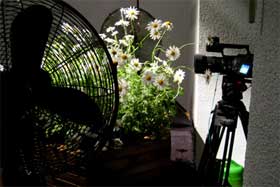 Project number 4* developed over the Interactivos? workshop at the MediaLab Madrid last month.
Project number 4* developed over the Interactivos? workshop at the MediaLab Madrid last month.
That one appealed to me a lot while i was visiting the workshop. All those daisies among just chips, broken bulbs, circuit boards, bits of cables and plastic!
I Thought Some Daisies Might Cheer You Up, by André Gonçalves, reacts to the displacement of the air that moves with us. Using people’s movement in the space, the installation simulates unnatural forces, in a poetic sense.
The room is divided in two parts. In the first half a computer vision system tracks user’s movement, direction and velocity; fans are activated via an Arduino board. If someone passes in a certain direction only the corresponding fan would be activated, the faster the movement, the faster the fans spin.
In the back room, there is a flower bed of daisies, leaving space for people to walk around it. In front of the flowers a camera captures video and sends it to the projector. The projection shows an image of the flower bed bending with people’s motion.
What inspired the idea behind *”I thought some daisies might cheer you up”?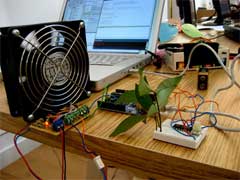
This installation have been in my mind for a couple years, at the time i was in residency at Experimental Intermedia Foundation in NY, so sometimes i liked to feel like a tourist and walkaround the city, that day i had in mind walking all the way down central park starting from Harlem, so at some point i climbed one hill and, without expecting it, i was facing the Jacqueline Kennedy Reservoir and i was instantly overwhelmed by that huge amount of water, it’s location and it’s surroundings, it instantly gave me the shivers! That state of conscience induced by the place itself made me enjoy the moment in a very emotional way. While holding that feeling i found myself watching the canes that grow on the shore, they were bending due to strong winds and they were making a really loud noise, i remember ignoring my skin senses and just imagined what if it wasn’t the wind that were bending the canes but, instead, sound itself. As if the sound was coming from somewhere else and when passing by those canes it was making them bend more or less accordingly to it’s amplitude, like if they were crouching, trying to hide from sound strength or performing choreographed movements with the sounds heard. After that i just wanted to explore how sound could be used as a movement inducer in order to recreate that experience and at the same time it triggered in me this idea of how to make a spectator believe in a not so natural behaviour when presented as a natural one.
The main difference between the finished work and the initial idea is the use of movement replacing sound, as if the air that we force to move when we move could have an effect on real objects, in a poetic sense it’s a tremendous amplification of our mass dislocation air-flow movement, the air that moves along with us.
The other difference is the subject to control, instead of canes i knew i wanted a flower, but it had to be as fragile as poetic, i instantly remembered of daisies for being the most simple and beautifull wild flower, at the same time i remembered this line from the song “Daisies of the Galaxyâ€? by Eels, where Mr. E(?) was picking up daisies for a friend in need, taken out of the context i like to keep in open who i really wanted to cheer up, a loved one, interactivos?, myself…
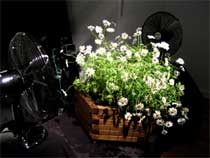
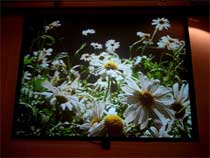 What was the biggest challenge in developing the project?
What was the biggest challenge in developing the project?
Definetly everything related with the control of the natural factor involved. As funny as it may seem, in the beggining of the development, the biggest problem appeared to be finding the proper daisies, although it was spring time flower shops in town only had one or two specific kind which didn’t suit because they were too big and hard to bend with the wind forces applied, fortunatly i had a big help from Gema e Paola, my always so kind volunteer collaborators, so they took me outside Madrid to a green house where they had all sorts of flowers, plants, vases, and got that sorted out, but then i faced one of my most important concerns, how to keep it’s “reality-ness�, the idea of controlling nature forces always seems very easy in sketches but, as in other of my experiences, the response is as surprising as it is not linear.
Because of that the biggest part of the time was spent in testing, testing, testing and testing it again, changing all the parameters that i could think of so to achieve the best settings for the the overall effect, also i had to look for fans that could bring the most to the installation, both in technical and aesthetic aspects, had to find the best position, the rotation speed, the hardware reaction factor, all this done with the time constraint flashing above, somewhere.
Do you plan to develop the idea any further?
Yes, this specific piece i would love to present it in a larger scale in a different setting where the installation, instead of two contiguous rooms, would be separated by a gallery window so that the first room would be the gallery sidewalk, reacting to the outside environment.
But what mostly interested me from the very start was having wind as an output of a whole system with the purpose of controlling a third element by a certain magical invisible force.
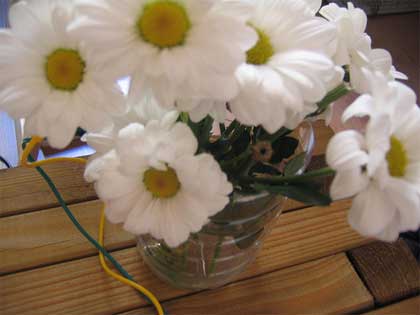 Work in progress
Work in progress
Since i left Madrid i have already made two new pieces using wind as a controller for physical events, both of them are exploring this in different directions but at the same time both are taking advantage of this poetic use of wind forces.
The first of them is a continuous levitation of a balloon, where one fan is faced up and a balloon located over it, the fan speed reacts to the sound amplitude of a chosen source so that the higher the volume the higher the balloon floats, i’ve been using it as a real-time video installation for my solo musical performances, but i’ve also been working on a bigger and standalone version…
The second is a collaboration with Pedro Boavida, a friend who’s also a musician, we were invited to play in this big one night event happening in Lisbon and we wanted to make something that could also work as an installation, after several days of brainstormings and experiments we ended up with this setup that consisted in five guitars, five fans, a sound mixer and some amplifiers, the guitars laid on the floor with the fans attached over the first fret blowing in the guitar’s body direction, both the wind and the fan vibration over the strings cause each guitar to resonate creating a soundscape based in the guitars tuning and the performance space resonant properties.
Both projects can be seen in my website in more detail.
Thanks André!
* Delicate Boundaries, Palimpsesto and Augmented Sculpture v 1.0.
See also Dandelion by Sennep, Sommerer & Mignonneau’s Interactive Plant Growing.
